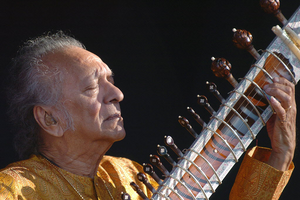Pandit Ravi Shankar: Not just a musician but Sanskrit scholar
Sitar maestro Pandit Ravi Shankar, who was also recognized as an exceptional scholar in Sanskrit language and a master of the Vedic scriptures, would have been 96 today.

In this July 19, 2005 file photo, Indian musician Ravi Shankar performs during the opening day of the Paleo Festival, in Nyon, Switzerland. Shankar, the sitar virtuoso, became a hippie musical icon of the 1960s after hobnobbing with the Beatles. Shankar introduced traditional Indian ragas to Western audiences over an eight-decade career.
Sandro Campardo/AP/File
Today’s Google doodle is a tribute to the legendary Pandit Ravi Shankar, a virtuoso sitar maestro who introduced Indian classical music to the world.
Designed by artist Kevin Laughlin, the Doodle celebrates Shankar, who would have been 96 today. Shankar is also recognized as an exceptional scholar in Sanskrit language, and a master of the Vedic scriptures, which is why his name is often preceded by the title "Pandit."
While he is best known today as a musician, Shankar didn’t start as one. He began performing as a dancer at the age of 10, before declaring his passion for music, and his love for the sitar at the age of 18. He learned to play sitar under the guidance of court musician Allauddin Khan.
Shankar spent his youth touring India and Europe. In 1930 he moved to Paris to be part of his brother's musical troupe, and later moved back to India to receive his formal training.
Born in 1920 as Robindro Shaunkor Chowdhury, the renowned musician is credited with paving the way for the use of Indian instruments in Western music, and introducing "the atmospheric hum" of the sitar to audiences worldwide.
One of his most far-reaching influences was on the Beatles guitarist and composor George Harrison, whom he met in 1966 and later taught to play the sitar. Through Harrison and his enthusiasm for the sitar, Shankar helped popularize the use of Indian instruments in pop music throughout the 1960s and beyond.
He further collaborated with the violinist Yehudi Menuhin, and worked with composer Philip Glass, with whom he created the 1990 album "Passages" – a blending of Hindustani classical music with American contemporary classic.
Rock music pioneers including the The Byrds and The Rolling Stones felt the influence of Shankar. The Byrds included some elements of Indian music in "Eight Miles High" and "Why" in 1965, while Brian Jones of the Rolling Stones used a sitar for their song "Paint It Black."
Laughlin’s Doodle design includes two bridges, one for the “drone” strings and the other for the melody string, and includes a second gourd-shape resonator at the top of the instrument's neck. The design is meant to depict the type of sitar that Shankar played.

